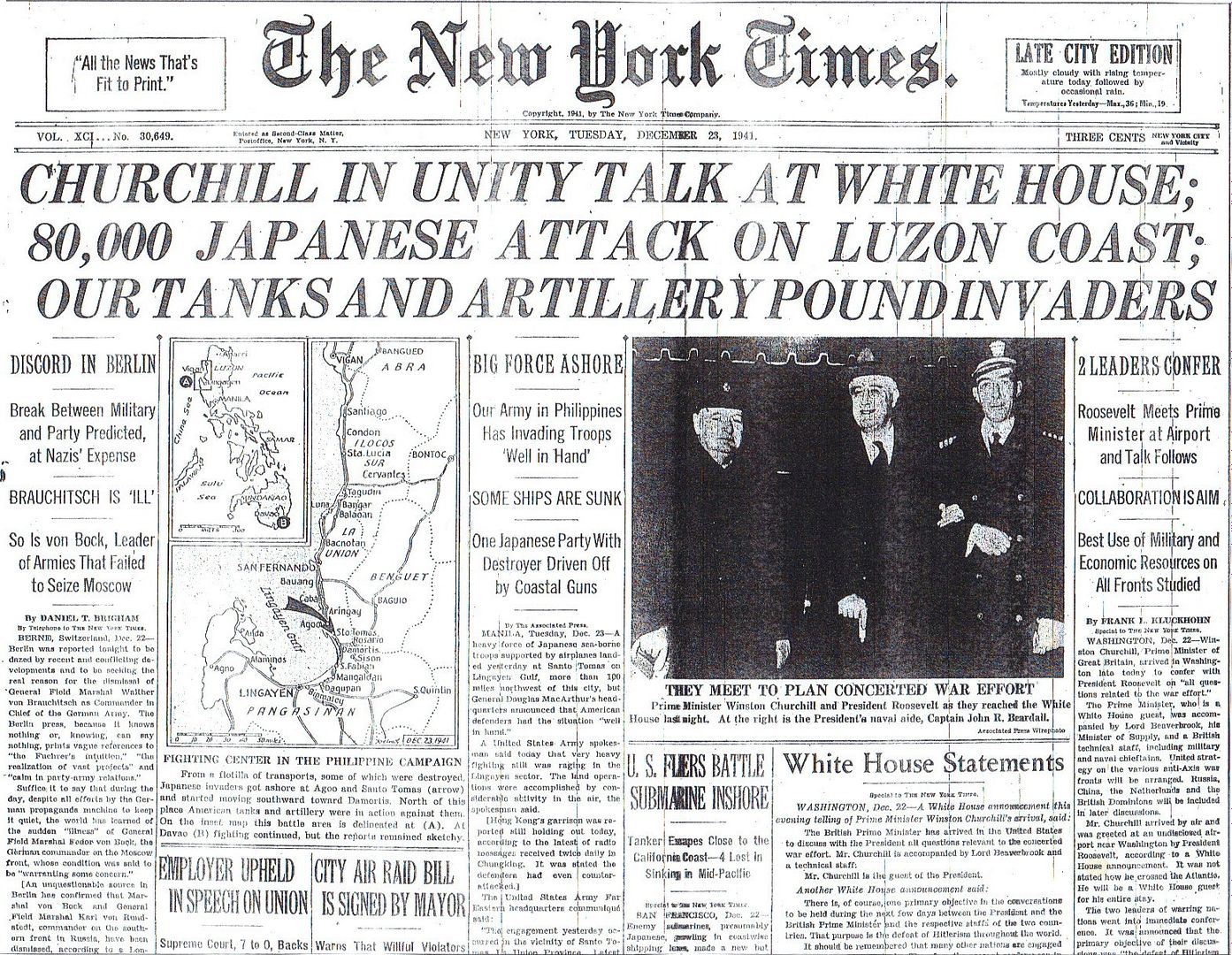
Posted on 12/23/2011 4:35:32 AM PST by Homer_J_Simpson

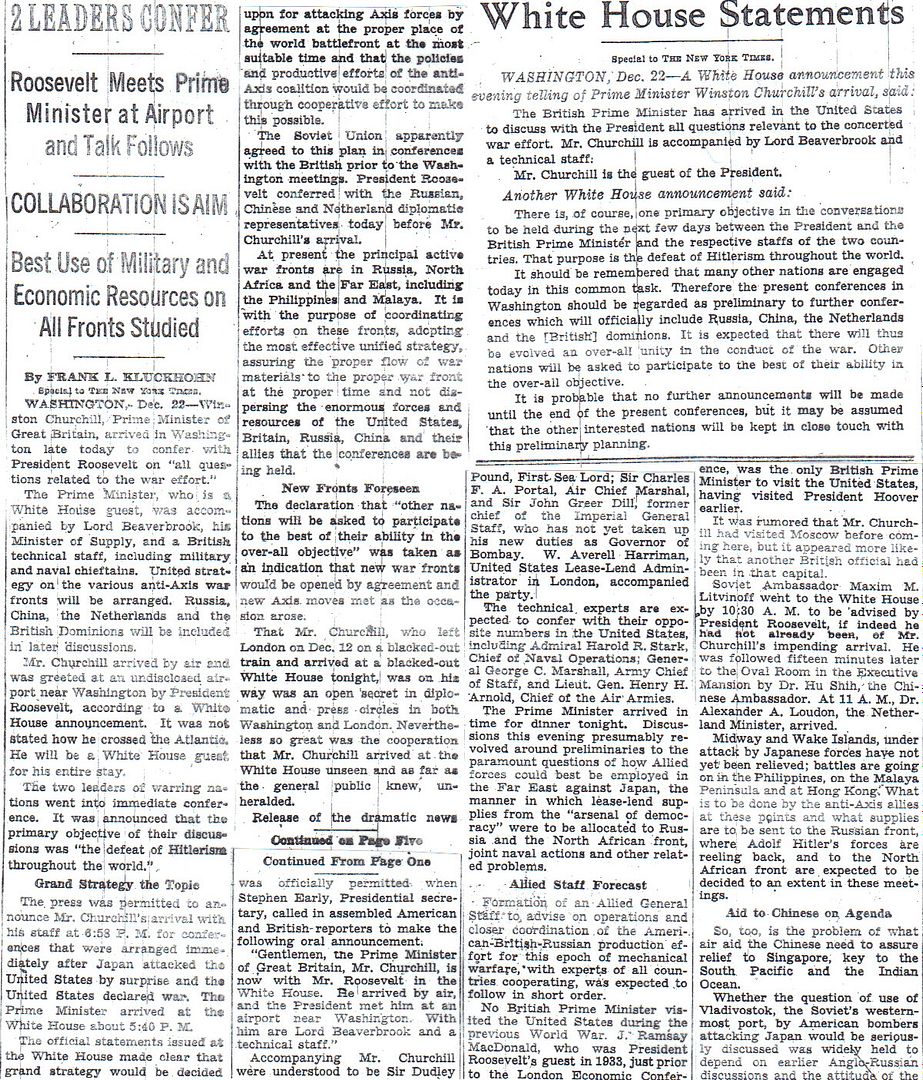
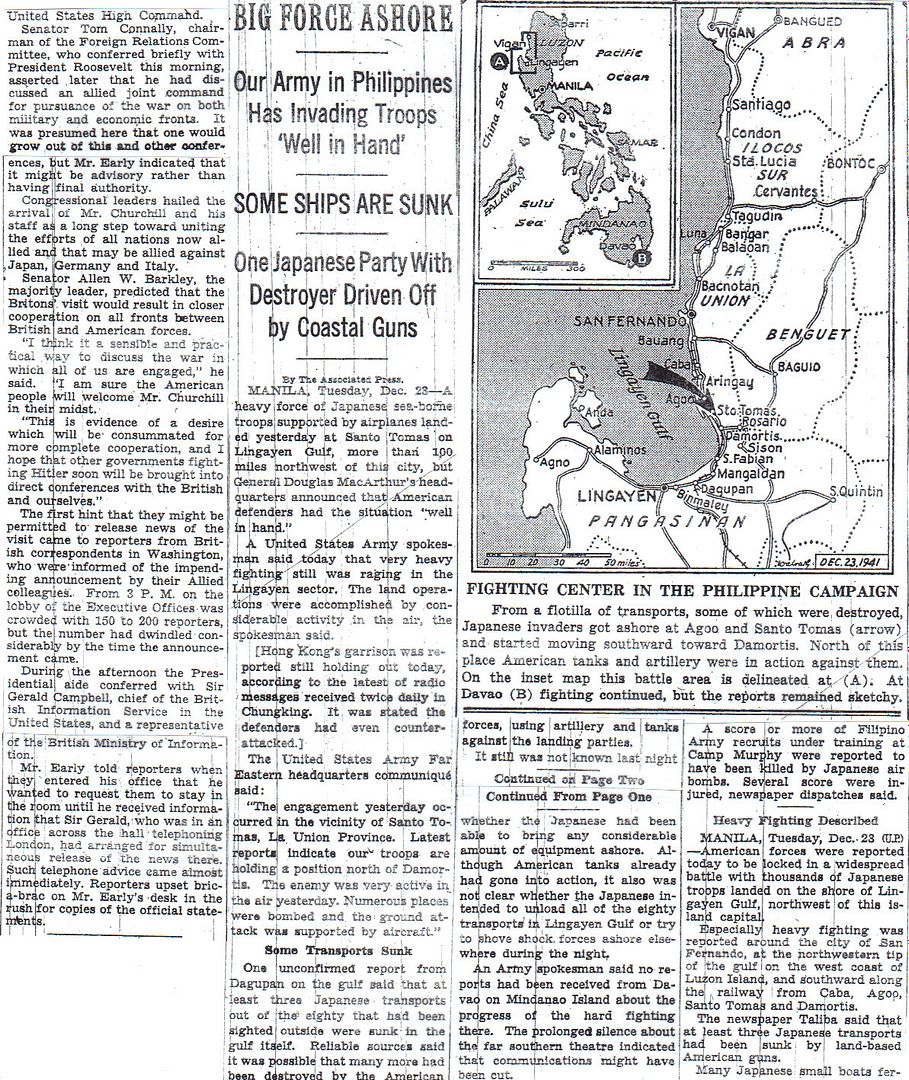
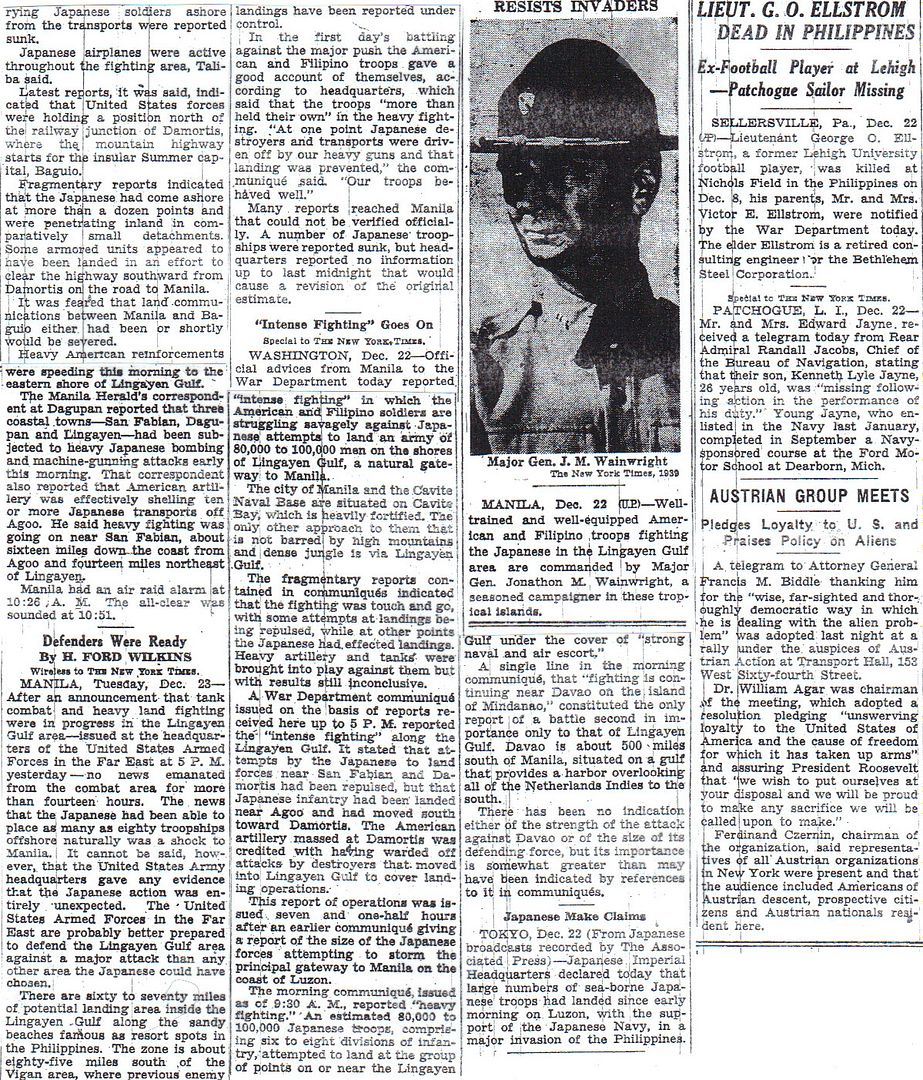

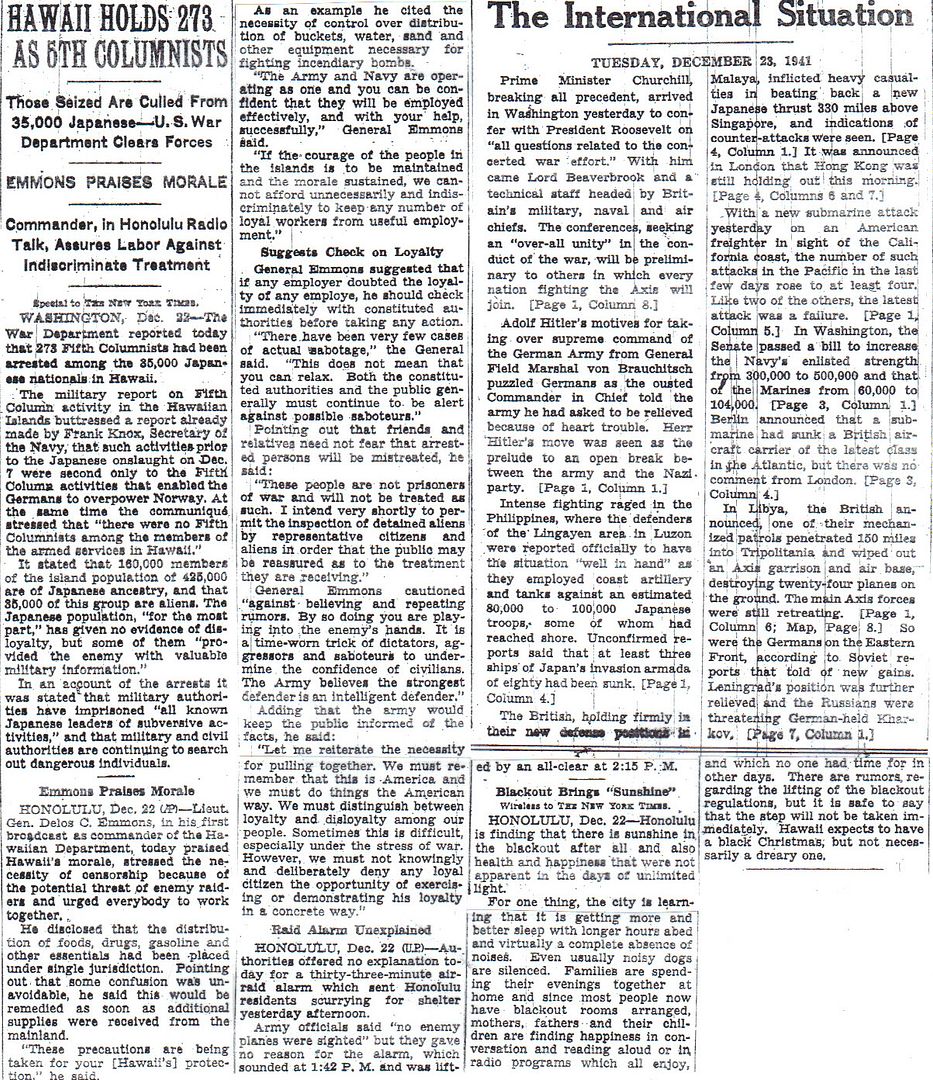
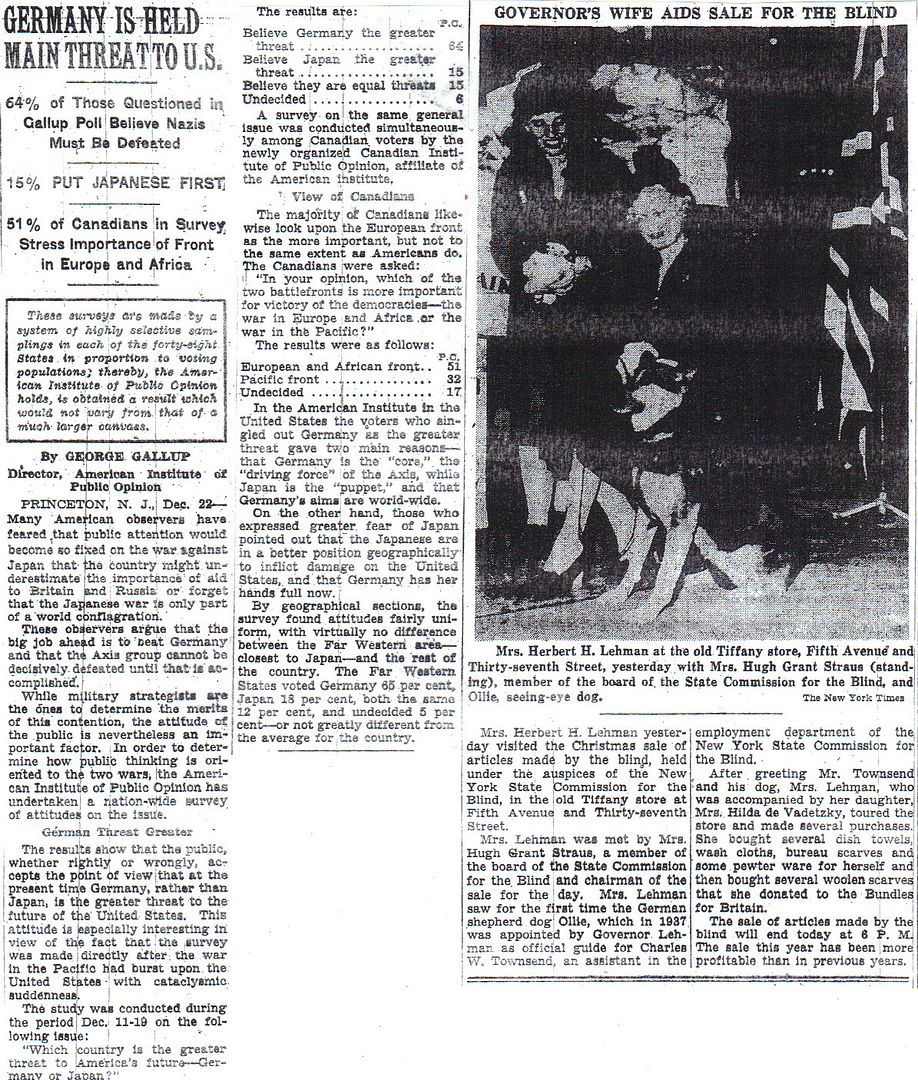

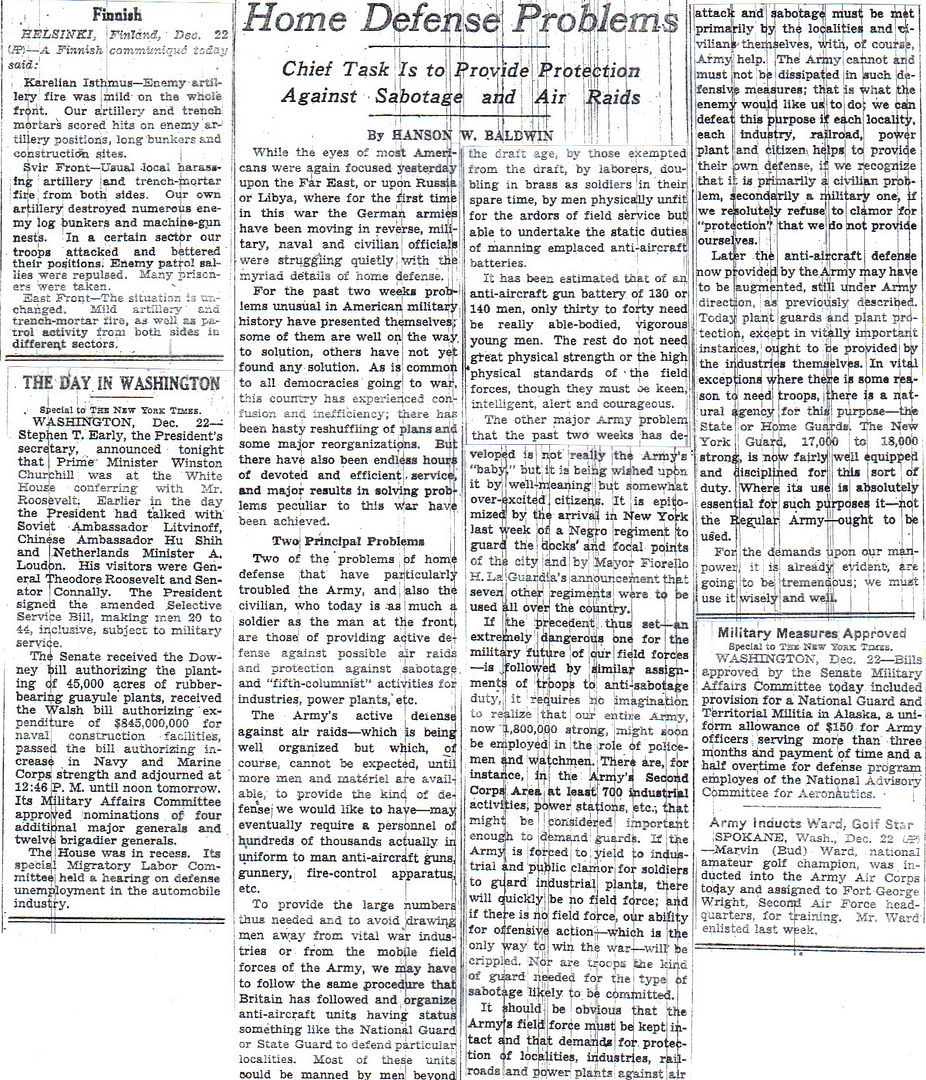
http://www.onwar.com/chrono/1941/dec41/f23dec41.htm
Axis abandon Benghazi
Tuesday, December 23, 1941 www.onwar.com
In North Africa... Rommel’s troops evacuate Benghazi. Allied troops enter Barce.
On Wake Island... The American troops surrender to the Japanese, the carriers sent to relieve them are still several hundred miles away.
In Burma... The first Japanese air attacks on Rangoon. The city’s air defense consist of only two fighter squadrons, one from the RAF, the other an American Volunteer Group
In Borneo... Japanese land troops at Kuching, the capital of Sarawak. Dutch submarines provide some resistance sinking two troops transports and a Japanese destroyer. A small British force continues to resist at Kunching.
http://homepage.ntlworld.com/andrew.etherington/month/thismonth/23.htm
December 23rd, 1941
UNITED KINGDOM:
Destroyer HMS Lauderdale commissioned.
Submarines HMS Untiring and Varangian laid down.
ASW trawler HMS Birdlip commissioned. (Dave Shirlaw)
GERMANY:
U-210, U-609 launched.
U-363, U-646 laid down. (Dave Shirlaw)
U.S.S.R.: The outer ring of Russian forts around Sevastopol is finally captured by the Germans.
MEDITERRANEAN SEA: U-79 sunk in the Mediterranean north of Sollum, in position 32.15N, 25.19E, by depth charges from destroyers HMS Hasty and Hotspur. 44 survivors (No casualties). (Dave Shirlaw)
NORTH AFRICA: Benghazi is evacuated by Rommel as the British 8th Army reaches Barce.
BURMA: Rangoon feels the first of the Japanese air strikes. There are two Allied fighter squadrons available. One RAF and the other is the American Volunteer Group (Flying Tigers). These fighters are only able to offer token resistance to the Japanese. Nevetheless 15 Japanese aircraft are shot down for the loss of three P-40s and two pilots, AVG pilots Henry Gilbert and Neil Martin, who are lost in action. (Chuck Baisden)
Chuck adds:
At our base at Mingaladon Airdrome just outside of Rangoon as one of the armorers in the 3rd Squadron AVG (Hell’s Angels), we had completed our morning preflight and a number of us crew chiefs, armorers and radio men were standing around on a small knoll just outside our barracks and perhaps a hundred odd feet from our flightline dispersal area when the air raid siren went off with our pilots racing to their planes, starting engines and immediately taxiing to the active runway and taking off.
It was a miracle there were no mid air collisions as some 14 P-40B fighters were taking off from one direction sandwhiched between a number of RAF Brewster Buffaloes (I believe they were New Zealand pilots) taking off from another dispersal area in almost opposite directions. It was right hairy for a spell.
Things got quiet and then from a distance we saw a rather large formation approaching our field, flying in a tight 3 ship V of V formation with fighter escorts swarming like a bunch of bees. Turned out there were 54 Japanese Betty bombers and some 40 fighter. One of our guys started counting and when he hit 27 yelled “Hell they are not ours, we don’t have that many.” There was an immediate mad dash for some slit trenches a few feet from where we had been standing.
One group of the bombers targeted our field and laid their pattern precisely down the runway and through our dispersal area. I remember those black dots getting larger and larger accompanied by a whoose-whoose sound and thought they were all aimed directly at me.
It was nothing compared to the shock of the bombs as they walked up the field with the noise getting louder and louder. The concussion bounced us around in the trench and from the smell someone had voided in his trousers. I know one 21 year old that grew up in a hurry.
Saw a parachute coming down with a Japanese I-97 making a pass at the helpless guy in the chute. Luckily one of the RAF pilots saw what the Jap pilot was up to and forced him to break off. Neil Martin, my pilot at Langley and Mitchel when we were pulling tow targets in an old Martin B-10, made a pass at the bomber formation and never pulled out of his dive, evidently killed by a bomber gunner. Henry Gilbert was also shot down and killed. My comrade-in arms R.T.Smith (Tadpole) shot down 2 or 3 and landed with his fuselage full of holes, a present from a Japanese bomber gunner. I had the privilege to fly as his gunner in B-25s with the Air Commando Group 2 years later.
Score for this day was 15 of the enemy and we lost 3 P-40s and 2 pilots. There were a number of casualties among support personnel in the RAF at our field and some 1000 civilians were killed or wounded in Rangoon.
The parachutist saved by the New Zealand RAF pilot was Paul J. Greene. (d. July 03, 2005) (Chuck Baisden)
COMMONWEALTH OF THE PHILIPPINES: Using a P-26A, of the Philippine 6th Pursuit Squadron, Lieutenant Jose Kare shoots down a Mitsubishi A6M2 Zero. (Rob George)
TERRITORY OF HAWAII: 1,000 troops of the Japanese Maizaru 2d Special Naval Landing Force (SNLF) land on the southwest shores of Wake and Wilkes Islands at approximately 0230 hours (all source disagree on the exact time). The two patrol craft (destroyer-transports) landing troops on Wake Island are run aground and abandoned due to severe damage by US Marine guns. Other troops are landed by up to six landing barges at various points. It is possible that small groups are landed by rubber boat within the lagoon. The 100 2d Company, Maizaru 2d SNLF troops landing on Wilkes Island near the new Channel are wiped out, but the force on Wake far outnumbers the defenders. Before dawn cruisers and destroyers provide fire support and air attacks commence after sunrise. In the early hours the US Marine commander is informed by Pearl Harbor that the relief expedition will not arrive within the next 24 hours. The Japanese force is firmly established ashore, the Marine defenders have suffered 40% casualties, most heavy weapons have been destroyed or captured, and organized resistance can not be sustained. At 0730 hours Commander Cummingham informs Major Devereux that the garrison will surrender to prevent needless loss of life. Once contact had been made with the Japanese it still takes several hours for the scattered defenders to be notified of the surrender. And then some refuse to believe it. Fire fights continue until all Marines have surrendered by approximately 1330 hours after a valiant defence.
Forty-nine Marines, three sailors, and about seventy civilians (there were many civilian construction workers on Wake) are killed during the battle. Something like 470 military personnel, of whom apparently about 400 were Marines, are captured, along with over a thousand civilians. In 1943 about a hundred of the civilians, still on the island, were executed. Duane Schultz indicates in his book, though, that 376 of the 400 captured Marines survived the war, which if correct is a surprisingly good rate considering the normal conditions of Japanese POW camps. (Arnold Lloyd Gladson and Keith Allen and Gordon Rottman)
NETHERLANDS EAST INDIES: Japanese troops land at Kuching on Sarawak.
A Dutch submarine torpedoes two Japanese transports. Resistance will continue until the 25th.
PACIFIC OCEAN: Tanker SS Montebello sunk by submarine HIJMS I-21 six miles off Cambria, Calif. (Dave Shirlaw)
Mexico breaks off relations with Bulgaria, Hungary, and Romania. (Dave Shirlaw)
ATLANTIC OCEAN: Convoy HG-76 is finally safe this morning after one of the toughest voyages ever. Trouble had been expected, so departure from Gibraltar was delayed until a powerful escort of two sloops, three destroyers, seven corvettes and HMS AUDACITY, a captured German liner converted to an aircraft carrier, was ready.
In the last six days 14 U-boats have attacked the convoy. Commander “Johnnie” Walker, an anti-submarine expert, used Audacity’s planes brilliantly and sank five U-boats, and shot down two long-range reconnaissance aircraft with the loss of only two of his 32 merchant ships. Yesterday U-751 sank Audacity, but was blown up herself hours later.
U-559 sank SS Shuntien. (Dave Shirlaw)
Thank you for posting. My dad was there in the Lingayan Gulf in Luzon, though he wasn’t there until early 1945.
My father landed farther north. Leyte Island, in late ‘44.
I’ll have to go back and check. Maybe it was Leyte. Was your dad with the 760th FA Bn?
http://ww2db.com/battle_spec.php?battle_id=119
First Washington Conference
22 Dec 1941 - 14 Jan 1942
Contributor: C. Peter Chen
The Arcadia Conference took place in Washington, United States, in which meeting Winston Churchill and Franklin Roosevelt concluded that despite the recent Japanese aggression toward US and UK holdings in teh Pacific, Europe remained the top priority of the Allies. The two leaders agreed that the military resources of the United States and Britain (with its Commonwealth forces) must be combined under one command in order to most efficiently fight the war against Germany. In addition, the United Nations was formally established during this conference on 1 Jan 1942.
Source: Wikipedia.
First Washington Conference Timeline
13 Dec 1941 British battleship HMS Duke Of York departed the Clyde, Scotland, United Kingdom with Winston Churchill on board, sailing for the United States. The battleship was escorted by destroyers HMS Faulknor, HMS Foresight, and HMS Matabele.
22 Dec 1941 The First Washington Conference (Arcadia) between Roosevelt and Churchill began with plans to organize a Combined Chiefs of Staff represented by both Americans and British.
23 Dec 1941 Churchill and Roosevelt met at the White House, Washington DC during the First Washington Conference (Arcadia).
128th Infantry, 32nd ID. What is an FA Bn?
Field Artillery battalion.
Field Artiller Batallion. I attended a reunion of my dad’s division several years back. There were only 8 guys there. One of them gave me a history of the 760th. Apparently a number of divisions were brought together to form a bigger division called the 99th? A woman sent me a history of the 99th several years ago. I hope I can find it. Forgive me, I’m not very good at military terminology, being an aging female! This larger division was the one that entered the Philippines at the northern end and was in battle for several months as it fought it’s way down to Manila.
Correction, it was the HQ 191st Field Artillery Group:
http://www.worldwar2history.info/forums/Main01/messages/260459947.html
"Nazis display the corpses of several thousand Soviet prisoners of war on a road in Minsk, Belorussia."
"In December 1941 mass executions of Jews from Odessa took place at Acmecetca and Dumanovca as well as at Bogdanovca, Romania (pictured), where the killings were particularly gruesome.
In the first phase of the Bogdanovca massacre, some 5,000 elderly and ill Jews were herded into stables, which were covered in straw, drenched with gasoline, and set afire; the prisoners suffered agonizing deaths."
"The military report on Fifth Column activity in the Hawaiian Islands buttressed a report already made by Frank Knox, Secretary of the Navy, that such activities prior to the Japanese onslaught on Dec. 7 were second only to the Fifth Column activities that enabled the Germans to overpower Norway..."
So far as any recent historical account will tell, all such reports of "Fifth Column activity" are pure figments in the imaginations of Knox, Roosevelt, Hoover & others.
If there ever were any actual incidents, they seem to have been scrubbed from the historical record.
A commonly held perception is that on Dec 8, 1941, U.S forces in the Philippines were as unalert or less alert than U.S. forces were at Pearl Harbor on Dec 7.
Many skillful people from many different angles over a considerable period of time have effectively crafted this perception.
Movies portray FDR giving MacArthur a Medal of Honor rather than court marshal purely to boost domestic morale.
Authors and commentators claim U.S. men in the Philippines on Dec 8, 1941 were sleeping off hangovers and their aircraft were sitting on the ground, unarmed with engines every bit as cold as they were in Pearl Harbor on Dec 7.
It's not unlike the perception created by the left that the unliateralist cowboy George Bush had no authorization to invade Iraq whereas both Clinton and Obama had U.S. Congressional and U.N. authorization for what they did.
Armchair pundits blast commanders for not having the clairvoyance only possible through hindsight to have deployed men differently or to have issued orders an hour earlier, etc.
From so many angles over such a period of time have these claims been made that it has become part of a collective understanding that commanders in the Philippines were every bit if not more offguard as those at Pearl Harbor.
So relentless and convincing have these stories been that people don't bother to examine first hand accounts of the men in the Philippines at the time. If they did, they would recognize the history they always heard was in fact a revised, alternate one.
For certain, tactical errors were made in the Philippines but tactical errors will always be made. Yes, a lot of records were destroyed and after the fact accounts must be relied upon in large part.
However, when reading the first hand accounts, no where does one find substantial differences or contradictions.
All accounts agree that Philippine forces had been on high alert prior to and on Dec 8, 1941. They all agreed that first line fighters were on combat patrols on Dec 8. They all agree that the B-17's at Clark Field had taken to the air on the morning of Dec 8.
The following snippets were taken from the war time diary of General Lewis H. Brereton, commander of the Far East Air Force in the Philippines. Yes, it's possible that he "modified" his diary entries and refined his recollection. For that reason, one must examine his account side-by-side with that of his peers.
These recollections must then be examined against the accounts of their subordinates and commander (MacArthur).
One must consider all these accounts in light of the poor electronic communications and that most orders on Dec 8 were being issued verbally.
Testimony of eyewitnesses will always differ here and there. However, nowhere in reading survivor accounts from the Philippines on Dec 8, 1941 will one find a major disagreement such as someone claiming American forces were under no alert or that front line aircraft were sitting on the ground unarmed with cold engines while their crews were sleeping off hangovers elsewhere.
If someone reading this and following posts has contradictory information, please post it in order that we all benefit and come to a better understanding of events in the Philippines in 1941-1942.
The following are snippets and their citations I extracted from the diary of General Brereton from the time he received orders to go to the Philippines in Oct 1941 until Dec 8, 1941. In some cases, I edited snippets to aid readability.
In light of War Plan Orange (created before an understanding of air power) which I will address in a later post, notice the instructions given Brereton on Oct 7, 1941 stressing the change in strategic importance of the Philippines.
Brereton, Lewis H. , (1946). Brereton Diaries: The war in the Pacific, Middle East and Europe, 3 October 1941 - 8 May 1945 (pp5). New York, NY: William Morrow & Co.
Washington, 7 Oct 1941. Gen George Marshall gave to Gen. Brereton detailed instructions about the Philippine situation, stressing the change in the strategic importance of the islands.
Brereton, Lewis H. , (1946). Brereton Diaries: The war in the Pacific, Middle East and Europe, 3 October 1941 - 8 May 1945 (pp8). New York, NY: William Morrow & Co.
Washington, 7 Oct 1941. "I repeated to Gen. Marshall my opinion that if the situation in the Far east was critical, or was expected to be so, the presence of a strong and unproteccted bombardment units might easily be a decisive factor to incite an aggressive enemy to air attack. The enemy would have everything to gain by neutralizing our bomber force before arrival of units necessary for their protection. I was told by Gen. Marshall as I had been told by Gen. Arnold that the hazards were recognized. Both were aware it was a calculated risk.
Brereton, Lewis H. , (1946). Brereton Diaries: The war in the Pacific, Middle East and Europe, 3 October 1941 - 8 May 1945 (pp8). New York, NY: William Morrow & Co.
Washington, 8-9-10 Oct 1941. "In any event it was the opinion of the War Department that hostilities, if and when they came, would not begin before 1 April 1942. Our plans for defense of the Philippines contemplated that by April 1942, the complete air reinforcements would be in place, and in addition that very considerable land reinforcements requested by General MacArthur would be in the Philippines.It was the hope of our Government that the presence of a powerful air force in the Philippines, in addition to a well trained Army, would serve as a strong argument to enforce the American viewpoint on Japan.
Brereton, Lewis H. , (1946). Brereton Diaries: The war in the Pacific, Middle East and Europe, 3 October 1941 - 8 May 1945 (pp10). New York, NY: William Morrow & Co.
Tampa, 12 Oct 1941. "While I did not feel that I was being sent out on anything like a hopeless task, I was made to understand that it was of the utmost urgency to be prepared to act at any time with the equipment at hand"
Brereton, Lewis H. , (1946). Brereton Diaries: The war in the Pacific, Middle East and Europe, 3 October 1941 - 8 May 1945 (pp11). New York, NY: William Morrow & Co.
Wake Island, 27 Oct 1941. Gen Brereton arrives aboard a Pan Am Clipper a few minutes ahead of a flight of B-17's enroute to the Philippines. This flight was one of several 3,6, or 9 plane groups totaling the 35 B-17's Gen Brereton will command in the Philippines. Due to small size of Pacific island airfields, larger flights could not be acomodated. Gen Brereton has dinner with Lt. Col Eubank, the B-17 flight leader.
Brereton, Lewis H. , (1946). Brereton Diaries: The war in the Pacific, Middle East and Europe, 3 October 1941 - 8 May 1945 (pp15). New York, NY: William Morrow & Co.
Manila, 3 Nov 1941. We arrived in Manila at 3:00am
Brereton, Lewis H. , (1946). Brereton Diaries: The war in the Pacific, Middle East and Europe, 3 October 1941 - 8 May 1945 (pp17). New York, NY: William Morrow & Co.
Manila, 4 Nov 1941. I spent the next morning with Gen MacArthur and gave him the letter from Gen. Marshall marked "For the Eyes of Gen MacArthur Only". After he read it and another communication I had for him, he acted like a small boy who has been told he is going to get a holiday from school. He turned to his chief of staff and said "Dick, they are going to give us everything we have asked for". After discussing with Sunderland the contents of the letter, he then gave me the most concise and clear-cut estimate of the situation I had yet received. In his opinion, which was the same as that of most informed men, it seemed likely that nothing would happen before 1 April 1942.
Brereton, Lewis H. , (1946). Brereton Diaries: The war in the Pacific, Middle East and Europe, 3 October 1941 - 8 May 1945 (pp19). New York, NY: William Morrow & Co.
Manila, 6 Nov 1941. I issued orders that one squadron of fighters and one squadron of bombers must be kept on constant readiness. Flightworthy aircraft were not to be placed out of commission during flying hours four routine checks and inspections.
Brereton, Lewis H. , (1946). Brereton Diaries: The war in the Pacific, Middle East and Europe, 3 October 1941 - 8 May 1945 (pp23). New York, NY: William Morrow & Co.
Manila, 9 Nov 1941. Information was correct that there were only two Philippine airfields from which heavy bombers could operate. One was Clark Field, adjoining Fort Stotsenberg, where all heavy bombers that had arrived were stationed., and where adequate housing facilities existed. The other was at Del Monte on Mindanao, where there was an adequate airfield but no facilities whatsoever.
Brereton, Lewis H. , (1946). Brereton Diaries: The war in the Pacific, Middle East and Europe, 3 October 1941 - 8 May 1945 (pp21). New York, NY: William Morrow & Co.
Manila, 9 Nov 1941. Half of the Philippine fighter force was stationed at Nichols Field, the remainder at Clark Field. As additional fields at Iba and Del Carmen were completed, the disposition of the fighters would be changed in order to provide better cover for Clark Field and the Manila Bay area. There were not AA defenses available at either of these fields or at any other airfield in the Philippines. The available AAA in the islands was concentrated on Corregidor. The air depot at Nichols field had no spare parts of any kind for P-40s, nor was there so much as an extra washer or nut for a Flying Fortress.
Brereton, Lewis H. , (1946). Brereton Diaries: The war in the Pacific, Middle East and Europe, 3 October 1941 - 8 May 1945 (pp22). New York, NY: William Morrow & Co.
Manila, 10 Nov 1941. In talks with MacArthur prior to my departure for Australia, I got the impression that his belief in 1 April as the earliest probable date when hostilities might commence had been severely shaken since my earlier coinferences with him.
Brereton, Lewis H. , (1946). Brereton Diaries: The war in the Pacific, Middle East and Europe, 3 October 1941 - 8 May 1945 (pp24). New York, NY: William Morrow & Co.
Manila, 28 Nov 1941. Brerenton returned to Clark Field from Australia and met with Gen. MacArthur and owing to the gravity of the situation with Japan, Brereton recommended to MacArthur that all the Air Force be placed on a war footing. MacArthur agreed and it was done at once. Blackouts were established at all fields and the depot. A 24-hour alert was established for half the bombardment force and fighter force. All air troops were kept on their stations, except the 15 percent permitted weekend leave.
Brereton, Lewis H. , (1946). Brereton Diaries: The war in the Pacific, Middle East and Europe, 3 October 1941 - 8 May 1945 (pp31). New York, NY: William Morrow & Co.
Manila, 29 Nov 1941. On of the major problems confronting us was location and dispersal of our aircraft. I anticipated that the Japanese would delay any landings until they had neutralized our Air Force, so we were much concerned over the location and overcrowing of our planes at Clark Field.
Brereton, Lewis H. , (1946). Brereton Diaries: The war in the Pacific, Middle East and Europe, 3 October 1941 - 8 May 1945 (pp31). New York, NY: William Morrow & Co.
Manila, 30 Nov 1941. Two messages from the War department, one on Nov 28 and the other on Nov 30 alerted us to the possibility of an attack by Japan at any hour.
Brereton, Lewis H. , (1946). Brereton Diaries: The war in the Pacific, Middle East and Europe, 3 October 1941 - 8 May 1945 (pp33 ). New York, NY: William Morrow & Co.
Manila, 1 Dec 1941. The Navy informed Gen Macarthur that their Catalinas could not continue air reconnaissance north to Formosa and at the same time give adequate attention to the areas west of Luzon. As a result, it was agreed that the Far East Air Force would take over reconnaissance towards Formosa, freeing the navy patrol wing to concentrate their reconnaissance to the west to Kamranh Bay and the southeast passage. I requested permission to conduct high-altitude photo missions of southern Formosa, particularly in the region of Takao. Gen. MacArthur directed that in view of the War Department instructions to avoid any overt act, he did not consider it advisable to conduct photo missions over Formosa.
Brereton, Lewis H. , (1946). Brereton Diaries: The war in the Pacific, Middle East and Europe, 3 October 1941 - 8 May 1945 (pp34-35 ). New York, NY: William Morrow & Co.
Manila, 4 Dec 1941. Throughout the hours of darkness for the past four nights, the Interceptor Command picked up and traced forces of strange aircraft estimated at from 9 to 27 bombers, which came from Formosa down to within 20 miles of the shores of Lingayen Gulf. There is little doubt that these formations were Japanese. Presumably, they were making trial navigation flights. With my chief of staff, Colonel Brady, and other staff members, I discussed the disperal and employment of our aircraft. The overcrowding at Clark Field invited an attack. I directed that steps be taken immediately to move two squadrons of Flying Fortresses, 16 aircraft, and a limited number of B-18's to be used for air transport to Del Monte. Approval for the movement of the 16 Flying Fortresses to Del Monte was obtained from the General Sutherland only with the understanding that they would be returned to airfields to be constructed on Cebu and Luzon as soon as the necessary operating facilities could be prepared.
Brereton, Lewis H. , (1946). Brereton Diaries: The war in the Pacific, Middle East and Europe, 3 October 1941 - 8 May 1945 (pp35 ). New York, NY: William Morrow & Co.
Manila, 5 Dec 1941. Sixteen Flying Fortresses of the 93rd and 14th Bomb Squadrons departed after dark according to plan from Clark Field for del Monte. In the event of hostilities it was planned to have them fly to Clark Field, refuel and carry out missions from there. Colonel Eubank, commander of the 19th bomb group advised against moving more than two squadrons to Del Monte because another group of B-17's, the 7th Bomb Group was to depart from the States for the Philippines the first week of December, and would also be based at Del Monte. The 7th Bomb Group never arrived in the Philippines. The first squadron from the 7th Bomb Group arrived at Honolulu the day Pearl Harbor was hit.
Brereton, Lewis H. , (1946). Brereton Diaries: The war in the Pacific, Middle East and Europe, 3 October 1941 - 8 May 1945 (pp36 ). New York, NY: William Morrow & Co.
MacArthur to Agwar, 6 Dec 1941. All air corps stations here on alert status. Airplanes dispersed and each under guard. All airdrome defense stations manned.
Brereton, Lewis H. , (1946). Brereton Diaries: The war in the Pacific, Middle East and Europe, 3 October 1941 - 8 May 1945 (pp36 ). New York, NY: William Morrow & Co.
Manila, 6 Dec 1941. I talked to Colonel Eubank at Clark Field and went over the plans for the alerting, briefing and entire procedure for a mission of hostilities broke out. There was no information as to the location of the main enemy forces, but we were certain that they must come from either the west or north. If west, the Navy would give us first information. If north, our reconnaissance planes would be the first to locate the enemy. Our photographs of Formosa were obsolete, so in view of this fact we selected Takao Harbor as the juciest target to bomb immediately on the outbreak of war.
Brereton, Lewis H. , (1946). Brereton Diaries: The war in the Pacific, Middle East and Europe, 3 October 1941 - 8 May 1945 (pp37 ). New York, NY: William Morrow & Co.
Manila, 8 Dec 1941. The telephone call from Gen. Sutherland notifying me that Pearl Harbor had been bombed woke me up. Around 4:00am while dressing, I notified my G-3, Col Caldwell to notify all air units of the Pearl Harbor attack and to have them prepared for action. I reported to Gen. MAcArthur's Hqs. at Ft. Santiago, Manila at about 5:00am.
Brereton, Lewis H. , (1946). Brereton Diaries: The war in the Pacific, Middle East and Europe, 3 October 1941 - 8 May 1945 (pp38 ). New York, NY: William Morrow & Co.
Manila, 8 Dec 1941. I requested permission to carry out offensive action imediately after daylight. I told Sutherland I wished to mount all available B-17s at Clark Field for missions previously assigned and to prepare B-17's at Del Monte for movement, refueling and bomb loading at Clark field for operations against the enemy on Formosa. General Sutherland told me to go ahead with preparations; in the meantime, he would obtain General MacArthur's authority for the daylight attacks.
Brereton, Lewis H. , (1946). Brereton Diaries: The war in the Pacific, Middle East and Europe, 3 October 1941 - 8 May 1945 (pp39). New York, NY: William Morrow & Co.
Manila. 8 Dec 1941. I told Colonel Eubank, who had flown down from Clark Field to plan to mount an operation against targets in Takaeo Harbor, Formosa, first objective enemy transports and warships, and to prepare three planes for a reconnaissance of air-fields on Formosa. At about 8:00am, Maj David Gibbs, operations officer of the 19th Bombardment Group, senior officer at Clark Field in Col. eubanks abscence, prdered all B-17's into the air when he received information that Jap planes were approaching. All B-17s able to fly took off until they were recalled through the group radio channel.
Brereton, Lewis H. , (1946). Brereton Diaries: The war in the Pacific, Middle East and Europe, 3 October 1941 - 8 May 1945 (pp39-40 ). New York, NY: William Morrow & Co.
Manila. 8 Dec 1941. At the same time, 18 P-40's of the 20th Pursuit Squadron at Clark Field and 18 P-40s of the 18th Pursuit Squadron at Nicholas field were dispatched to attempt interception. At 9:00am when no word was received of any contact with the enemy, I ordered Col. George to undertake fighter cover of Clark and Nichols Fields. About 9:10 he reported that he had 54 aircraft in the air and 36 in reserve. Within 15 minutes information was received that twin motored Jap bombers had attacked Tuguegatao, Tarlac, and Baguio on northern Luzon. The fighters were recalled for refueling.
Brereton, Lewis H. , (1946). Brereton Diaries: The war in the Pacific, Middle East and Europe, 3 October 1941 - 8 May 1945 (pp40 ). New York, NY: William Morrow & Co.
Manila. 8 Dec 1941. Col Eubank left for Clark Field at 10:10am and just before he departed Gen. Sutherland advised that Gen MacArthur decided that a reconnaissance mission could be sent to Formosa.
Brereton, Lewis H. , (1946). Brereton Diaries: The war in the Pacific, Middle East and Europe, 3 October 1941 - 8 May 1945 (pp40 ). New York, NY: William Morrow & Co.
Manila. 8 Dec 1941. At approximately 10:20am, the Air Warning Service again reported a force of enemy aircraft over Lingayen Gulf headed for Clark Field and Manila. Fighters were ordered to scramble and 18 P-40s each from the 17th squadron at Clark Field and the 21st squadron at Nichols Field took off to cover the Manila area. Eighteen P-40's of the 3rd squadron from Ilba took off and headed north to attempt interception. Another 18 P-35's of the 34th squadron took off from Del Carmen to cover Clark Field. The 20th squadron at Clark Field was kept in reserve.
Brereton, Lewis H. , (1946). Brereton Diaries: The war in the Pacific, Middle East and Europe, 3 October 1941 - 8 May 1945 (pp40 ). New York, NY: William Morrow & Co.
Manila. 8 Dec 1941. Col Eubank, on arrival at Clark Field sent a coded radio message recalling the bombers. The bombers trickled back to Clark Field, refueled and prepared to execute the orders-three planes to go on a reconnaissance to Formosa and the rest to be briefed for an attack.
Brereton, Lewis H. , (1946). Brereton Diaries: The war in the Pacific, Middle East and Europe, 3 October 1941 - 8 May 1945 (pp41 ). New York, NY: William Morrow & Co.
Manila. 8 Dec 1941. About 11:00am, I received a call from Gen Sutherland informing me that bombing missions could be executed. I directed Col. Eubank at Clark Field to load all available B-17s with 100lb and 300-lb bombs and brief his crews to attack known airfields in southwest Formosa.
Brereton, Lewis H. , (1946). Brereton Diaries: The war in the Pacific, Middle East and Europe, 3 October 1941 - 8 May 1945 (pp41 ). New York, NY: William Morrow & Co.
Manila. 8 Dec 1941. About 12:30pm, an estimated 54 Japanese bombers flying in two waves attacked Clark Field from high altitude. The three reconnaissance B-17s which were being taxied into position for takeoff by the crews were hit and destroyed. Three planes of the 20th pursuit squadron led by Lt. Joe Moore were able to get off but several other P-40s were hit and destroyed on the runway. The high altitude bombing was followed by a series of attacks by about 30 dive bombers and strafers covered by about 40 fighters. The attack on Clark Field came without warning.
Brereton, Lewis H. , (1946). Brereton Diaries: The war in the Pacific, Middle East and Europe, 3 October 1941 - 8 May 1945 (pp41 ). New York, NY: William Morrow & Co.
Manila. 8 Dec 1941. About 10:30am, the 3rd pursuit squadron at Ilb took off to intercept a formation of Jap planes which were plotted on the radar approaching over the China Sea. The 3rd squadron failed to intercept the Japs and were coming in to refuel when the Jap fighters attacked Ilba. Approximately 16 P-40's were lost at Ilba and in addition, the one radar air warning set in operation along with other ground installations was destroyed. Loss of the radar set at Ilba proved to be fatal, permitting a following formation of bombers and fighters to get to Clark Field without warning.
Brereton, Lewis H. , (1946). Brereton Diaries: The war in the Pacific, Middle East and Europe, 3 October 1941 - 8 May 1945 (pp42 ). New York, NY: William Morrow & Co.
Manila. 8 Dec 1941. All during the Clark Field attack there were 36 P-40s and 18 P-35s airborne and covering Nichols Field, Cavite and Manila, 55 miles south of Clark Field. Efforts to get orders to this fighter force to proceed to Clark Field were unavailing because the one radio set available had been hit in the initial attack. All during the day communications were conducted under the most difficult circumstances owing to the shortage of radio and telephone equipment. All phone calls were made over the Philippine Commonwealth lines except to Gen MacArthur's Hqs., where we had a field telephone; this line we suspected was tapped by enemy agents.
Brereton, Lewis H. , (1946). Brereton Diaries: The war in the Pacific, Middle East and Europe, 3 October 1941 - 8 May 1945 (pp43 ). New York, NY: William Morrow & Co.
Manila. 8 Dec 1941. Col Eubank reported that 17 B-17s had been destroyed or put out of commission on Clark Field. (leter repair and salvage reduced the number to 12 B-17s). The only B-17 at Clark field not hit was the aircraft flown by Lt. John W. Carpenter III, unable to take off until after 10:00am due to generator trouble. Carpenter was 200 miles northeast of Clark Field when ordered by radio to return. All during the Clark Field attack there were 36 P-40s and 18 P-35s airborne and covering Nichols Field, Cavite and Manila, 55 miles south of Clark Field. Efforts to get orders to this fighter force to proceed to Clark Field were unavailing because the one radio set available had been hit in the initial attack. All during the day communications were conducted under the most difficult circumstances owing to the shortage of radio and telephone equipment. All phone calls were made over the Philippine Commonwealth lines except to Gen MacArthur's Hqs., where we had a field telephone; this line we suspected was tapped by enemy agents.
Brereton, Lewis H. , (1946). Brereton Diaries: The war in the Pacific, Middle East and Europe, 3 October 1941 - 8 May 1945 (pp43-44 ). New York, NY: William Morrow & Co.
Manila. 8 Dec 1941.Fighter losses for the day were approximately 45 with many others damaged. The events of the day as I have outlined them were as I saw them from my command post at Nielson Field, on the edge of Manila, 60 miles south of Clark Field.
Brereton, Lewis H. , (1946). Brereton Diaries: The war in the Pacific, Middle East and Europe, 3 October 1941 - 8 May 1945 (pp43-44 ). New York, NY: William Morrow & Co.
great post.
A very interesting addition to the story. So he claims that they launched the B-17’s against the Japanese in Formosa but they were later recalled?
A quick retaliatory strike would have gotten great press I bet.
Damn!
That is one LOOOONNNGGGGG ping!
Thanks but the thanks are really due to Homer who without his greatly appreciated efforts to post daily headlines from 70 years ago, would not have created an adequate forum to begin this discussion.
A very interesting addition to the story. So he claims that they launched the B-17’s against the Japanese in Formosa but they were later recalled?
This is where you start getting into the fog of war.
A Japanese attack was expected in the morning, Brerenton claims he wanted to immediately launch an attack against Formosa but MacArthur hesitated. Never-the-less, when expecting to be attacked, you would naturally want to get combat worthy aircraft into the skies. In the case of the B-17's, you got them into the skies in order to disperse them.
However, the expected early morning Japanese attack to the Philippines never came. Unknown to the Americans, bad weather over Formosa delayed the Japanese attack. From what I can tell, no Americans knew why the expected Japanese attack had not been made. No reconnaissance info was available about Formosa either.
MacArthur suspected the reason for no Japanese attack being that the Japanese must have received a severe setback at Pearl Harbor and called off their attack on the Philippines.
When the Japanese attack was finally delivered to Clark Field, Col Eubanks was in the process of briefing aircrews on the photo-reconn mission to Formosa. Why Colonel Eubanks recalled all the B-17s to Clark Field when only a 3 B-17 photo-reconnaissance mission to Formosa was ordered appears to be one of those things that happens in the fog of war.
Colonel Eubank, in one of his telephone reports stated he was actually briefing the pilots who were to go on that photo-reconnaissance mission when the attack came.A quick retaliatory strike would have gotten great press I bet.Brereton Diaries: The war in the Pacific, Middle East and Europe, 3 October 1941 - 8 May 1945 (pp42 ). New York, NY: William Morrow & Co.
If successful yes. However, without fighter escort and no tailgunners, the small force ofB-17's would likely have been badly mauled.
And I expect it will grow longer and hopefully result in a better understanding of events surrounding the Japanese attack in the Philippines on Dec 8, 1941.
Disclaimer: Opinions posted on Free Republic are those of the individual posters and do not necessarily represent the opinion of Free Republic or its management. All materials posted herein are protected by copyright law and the exemption for fair use of copyrighted works.